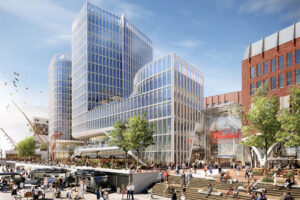ACROSS: The real estate sector is responsible for approximately 40% of global energy consumption and emissions. What is Redevco’s reaction to that fact?
CLEMENS BRENNINKMEIJER: That’s a good question. As an international real estate asset manager, we take this issue very seriously. We want to act in a responsible manner. We want to ensure that the impact of our properties on the climate is kept to a minimum.
In other words: We want to future-proof our assets via our own activities. Furthermore, we may be able to influence others by demonstrating that having a positive impact is possible. We want to encourage others to do the same. Our standpoint is that doing the minimum is not sufficient. We have a responsibility to do more.
ACROSS: That sounds like a long-term view, doesn’t it?
CLEMENS: When we talk about energy consumption, emissions, etc., we also have to look at our philosophy as a company: Redevco was founded 1999 as part of a 175 year’s old family business in its sixth generation. Therefore, yes, we have always had a long-term view. We want to ensure that future generations can enjoy our planet in the same way as we do. That’s another reason for us to do all that we can with regard to our portfolio.
Through this holistic approach, we attempt to incorporate a concept that we call “Business in Balance”, which means bringing economic, social and environmental interests in equilibrium in all that we do.
ACROSS: What are the measures that Redevco is taking?
CLEMENS: We have been working on an environmental program for our assets for 10 years already. We decided to adopt the BREEAM methodology due to the fact that it is an internationally recognized methodology used to measure and monitor the environmental performances of buildings. In the last decade, we have learned how to use BREEAM, and we started to certify our portfolio approximately seven years ago.
Currently, approximately 90% of our portfolio under management is BREEAM certified, however it is only a method to measure where we stand. It allows us to plan improvements that will increase the buildings’ environmental performance and thus making them more future-proof. . As BREEAM provides a holistic approach, we not only focus on energy consumption, but you also take a look at materials that you use, transport issues, as well as water and waste management. For large-scale measures, redevelopment phases are ideal.
ACROSS: How do you approach each individual property?
CLEMENS: We incorporate our BREEAM assessments and gaps into our annual business planning cycle at asset level. As a result, every asset has a plan for the upcoming period.
The responsible asset managers make conscious decisions about which ones can be improved – and via which credits and activities. There are numerous options. A typical thing that landlords can do involves improvement of building insulation, both behind the facades and, particularly, under the roof.
Furthermore, we encourage our tenants to also make the right decisions. To restate a previous point: It’s not just about environmental factors: It’s also about the positive social impact our (re)developments can have. We try to create interesting environments, using innovative architecture, where consumers want to spend their time, and, hopefully, we encourage other landlords in the same area to upgrade and improve their assets as well.
Sign up for our ACROSS Newsletter. Subscribe to ACROSS Magazine.






![Titel_Across_1_24_Endversion[111270] Titel_Across_1_24_Endversion[111270]](https://www.across-magazine.com/wp-content/uploads/elementor/thumbs/Titel_Across_1_24_Endversion111270-qjpg2yp7x6msxzo90wpo62uop32tmjtjils84ezryg.jpg)
